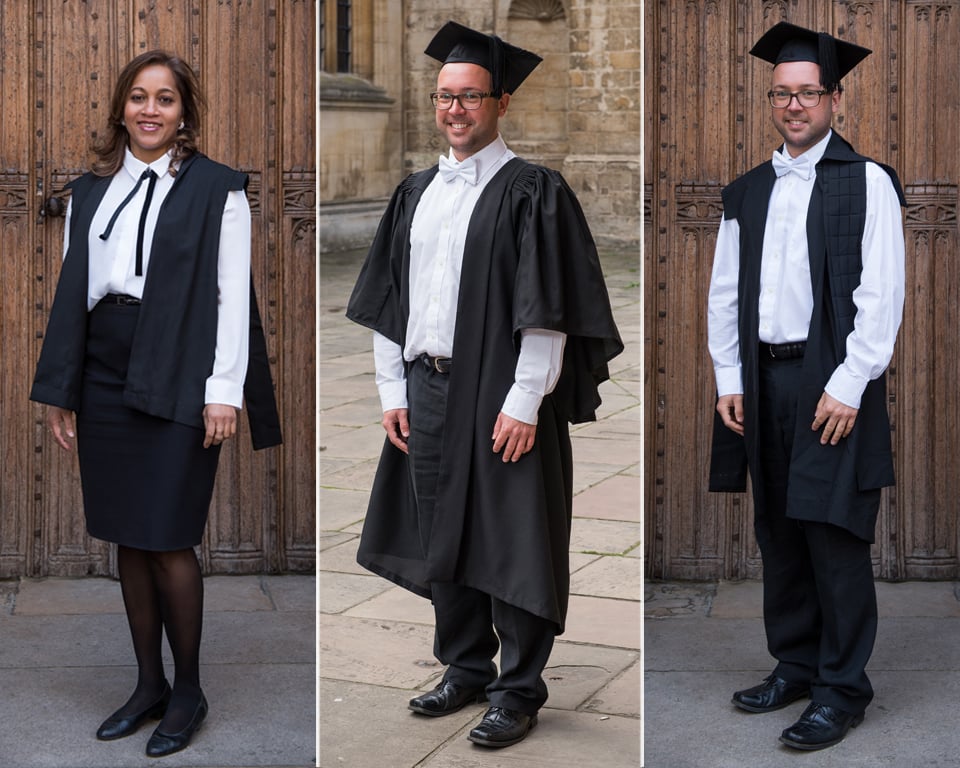
Academic dress
Full academic dress should be worn at all formal University ceremonies including matriculation and degree ceremonies. Sub fusc (from the Latin sub fuscus meaning very dark) should be worn beneath your academic gown and is also required when sitting examinations.
Sub fusc and the wider academic dress code at Oxford is solemn and modest, in line with our ceremonies, and traditionally comprised of plain black dress. Solemn ceremony is observed to focus on the University bestowing what is most precious to it, namely membership and degrees, while paying respect to those who have earned this most precious prize.
Your sub fusc
You are required to wear your preference from the following as sub fusc:
1. one of:
- dark suit with black socks, or
- dark skirt with black tights or stockings, or
- dark trousers with black socks or black hosiery
Socks, tights and stockings must be worn and must cover the ankle entirely. There should be no gap between the bottom of the trouser leg or skirt and the top of the socks or stockings.
2. dark jacket, if required - worn underneath the gown
3. plain black shoes with a dark sole
4. plain white collared shirt or blouse with sleeves
5. white bow tie, black bow tie, black full-length tie, or black ribbon.
PLUS:
- the appropriate academic gown (see below; Academic Gowns for Students)
- mortar board or soft cap
Additional notes
- ‘Dark’ in this context generally means black, a very dark charcoal grey, or very dark blue may be permitted, but must be virtually black. All clothing must be plain; pinstripes or patterns are not permitted.
- When wearing sub-fusc, your clothing must not leave any part of your legs, ankles, or feet uncovered.
- The mortar board may be worn outdoors but must be removed as you enter buildings and carried whilst indoors. Soft caps may be kept on indoors.
- Ministers of religion may wear clerical dress, with a gown over, when attending ceremonies.
- If you wear a head dress / scarf for religious reasons, a black scarf should be worn.
- Members of the armed forces may wear service dress under their gown, in place of sub fusc. This is only applicable to members of The British Armed Forces in the UK. Uniform caps should be removed when indoors.
Student members not in appropriate full academic dress may not be permitted into matriculation or degree ceremonies.
Students who are not able to wear traditional sub fusc for religious or health reasons are encouraged to contact their college in advance for support requesting a dispensation from the Regulations. Dispensation requests should be made in advance to the Proctors who can be contacted at [email protected]
Gowns and sub fusc can be purchased or hired from a number of suppliers across Oxford.
Academic gowns for students

Student gowns: Commoners gown (left), Scholars gown (middle), Advanced student gown (right)
Commoners gown
Worn by students taking undergraduate or undergraduate master’s degrees: BA, BFA, BTh, MPhys etc
Black gown of cotton or synthetic material with a turned over collar. It has no sleeves but has a streamer on each side with square pleating hanging to the full length of the gown, which falls to the hip.
Scholars gown
- Worn by students taking undergraduate or undergraduate master’s degrees, and: are the recipient of a scholarship* AND/OR have excelled in their preliminary examinations*
*Your college can advise you further.
- Black gown of Russell cord or synthetic material in full style with a gathered stiffened yoke behind and short open sleeves. The gown should reach the wearer’s knees.
Advanced students gown (also known as the Graduate gown)
Worn by those taking postgraduate taught, or postgraduate research degrees (e.g. MSc, MPhil, DPhil etc.)
- Black gown of cotton or synthetic material of the same style as the Commoners’ gown, but reaches to the knees of the wearer.
Information for examinations
You are required to wear sub fusc for all your examinations; plus your academic student gown and mortar board/soft cap. Your college/department can advise you on the appropriate gown to wear (see above; Academic Gowns for Students)
- Undergraduates/Undergraduate Masters: For music recitals, oral examinations, presentations and any other form of viva voce examination, you must always wear the commoners’ gown.
You may remove your mortar board/soft cap and gown during the examination itself.
In addition, students traditionally wear carnations for examinations (though this is not compulsory):
- First examination = a white carnation
- Intermediate examination(s) = a pink carnation
- Final examination = a red carnation
Degree ceremonies
In all cases you are required to wear full academic dress to your degree ceremony. If not properly dressed you may be refused admission to the degree ceremony and graduated in absentia. For most degree ceremonies, you will be required to change your academic gown and/or hood during the ceremony.
Students having a DPhil or Higher Doctorate conferred should wear the gown of their existing University of Oxford status (and the hood if there is one) during the first part of the ceremony. You will change into the gown (and hood if applicable) of your new degree at the appropriate time during the ceremony.
Students having a graduate masters degree conferred, and students having the degree of BA, BFA, BTh, Undergraduate Masters (e.g. MBiochem, MChem, MMath etc.) conferred, should consult their college as to whether they should enter the ceremony wearing the gown of their current status, or the status which will be conferred. In all cases, the gown and hood of the status to be conferred will be required as a minimum.
Your college will advise you about which gown(s)/hood(s) you will need for your degree ceremony.
Mortar boards may be worn outside, but removed when inside and carried. Soft caps and bonnets may be worn inside and outside.